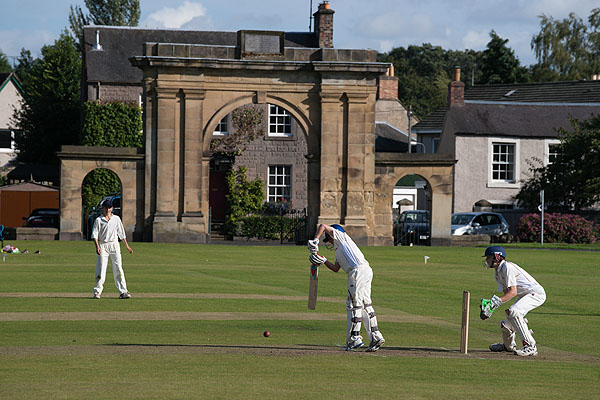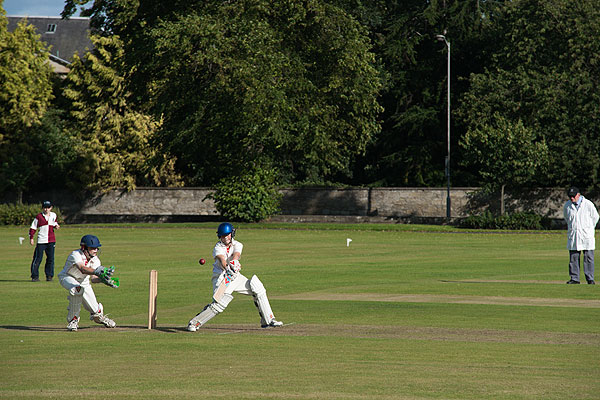Crop or cram? Pixel density versus the big view…
The Alpha 900 offers an unrivalled view through its 100% prism finder. The extra brightness, as well as the size and clarity, make most subjects far easier to photograph well. For some users, however, the full frame camera brings a disadvantage in terms of reach and resolution. You need lenses 50% longer (and thus twice the size, and four times the cost!) to fill the frame with the same distant sports and wildlife subjects. I don’t need to remind anyone how popular these two subjects are with amateurs, and sometimes, how important to professionals.
I took three cameras – the Alpha 900, Alpha 700 and Alpha 380 – and three lenses – the 70-300mm Sony G SSM, the Sigma 70-200mm EX DGII Macro HSM, and the Sigma 18-250mm EX DC HSM optically stabilised superzoom. The subject was a Scottish Under-15s cricket match held just over the road from my office, but time and the evening light dictated carrying all three together. While juggling bodies and lenses one combination, the Alpha 700 with 70-300mm G, was omitted. The Alpha 380 got tested with all three lenses. The Alpha 900 didn’t get used with the 18-250mm as it’s an APS-C lens.
But, it could have been. Although the Sigma does not auto-switch the A900 to APS-C crop mode, I could have selected that on the camera menus manually. The question being answered is one posed on the Photoclubalpha Forums. Does a crop from the A900 match using an A700 or A380? Is it better or worse?
Alpha 900 full frame 24 megapixel cropped to 10.7 megapixel results

Here is an A900 shot taken at 200mm using the 70-300mm Sony G SSM, at f/8. It was necessary to use manual exposure at preview as metering simply didn’t work with the cricket whites – 1/1250th seemed best at ISO 320. Cricket needs exposures of 1/1000th or shorter, and the lens is f/5.6 maximum aperture, benefiting a lot from that one-stop down closure to f/8. So although the sun is out, this is a situation where ISO 320 is only just high enough. It is slightly tilted, and the framing has plenty of space to allow an APS-C crop which corrects that:

Clicking this image will open a pBase file page with the option to view full size. Exactly what is full size? It is 10.7 megapixels, or 3960 x 2640. This compares with the 4272 x 2848 of the Alpha 700, and the 4592 x 3056 of the Alpha 380. There is no real doubting the quality of the Alpha 900 file, which is here processed without using sharpening, noise reduction or any lens corrections in Adobe Camera Raw. A strong tone curve and a small adjustment to white balance and black point bring the image closer to in-camera JPEG tonality.
Here is an Alpha 900 shot using the Sigma 70-200mm EX DGII HSM, again at f/8 and the same settings exactly, with the full frame:

You will notice that the batsman is more or less central in both shots, one to the right, one to the left. Single-frame AF and lock (shutter pressure) was used with the central f/2.8 AF cross sensor. Space must be left to the front of the batsman to see the ball enter the frame – this is a possibility with the fast shutter reactions of the A900, and the extra frame area. Jerking the camera in a pan movement would risk losing sharpness even at 1/1000th or faster. Therefore, the APS-C crop is not from the central sweet spot of the lens, but one edge, and in the conversion below I have used no CA correction, sharpening, or NR etc.

Once again, click the image to go to the pBase full sizer option. There is no doubt, after shooting a few dozen of these cricket shots with all three cameras, that the Alpha 900 enabled me to time my single exposures almost perfectly every time. The extra space round the subject gace more room for the ball to be shown in-frame, and to see it arriving even if the bulk of the camera prevented my ‘second eye’ observing the bowler – I had to time by sound as well as vision. In nearly all cases, the sound of my shutter firing reached my ear before the sound of the ball on the bat.
To experiment, I did try some 5 fps sequences as well. These were fascinating in that they showed the speed of reactions of the batsmen moving off for a run when the ball was only a yard or two off the bat (they could tell whether it was going in the right direction!) but in most cases no single shot was as accurately timed as a one-off. Within three frames, the ball could be six feet in front of the batsman, disappear behind the bat and appear six feet behind. To capture something as simple and static as a young amateur batsman in action, something more like 15 frames a second would be needed. I also tried 3 fps and the Alpha 380’s modest 2.5 fps. That mainly missed the moment entirely!
Here, finally from the Alpha 900, is a full frame taken with the 70-300mm SSM lens set to 300mm – using the benefit of 24 megapixels fully:

Here, my timing was a little early because I had to use judgement with no chance to see the ball entering the viewfinder. Again, click to visit a full 24 megapixel file from this shot. The 70-300mm SSM G is very free from CA and the ‘neutrally processed’ image is very clean. Because of the shutter speed involved, SSS was turned off for all these images. If I was shooting sport with the A900, I would always use full frame, and never use the manual crop option. The chances of getting some action within the frame, rather than too close to the edge or cut off, give the full frame a real value.
Now we move on – to the Alpha 700.

A very interesting comparison……
Three generations of Alpha – ok, well two and a half, because the A100 was the first generation!
The improvements in the image quality are quite interesting to note. The A900 has better quality than the A700, but the A380 is possibly the best for a small resolution image. It would be interesting to see the direct comparison (at 100%) between the three cameras, with the same lens at the same settings. I am sure that the 24Mpx A900 will produce better detail in a print or overall image, because of the relatively smaller pixels, but the A380 may well surprise us all.
Thanks for taking the time to think this one out!
Yes, I think the 14 megapixel sensor is up to the quality of the A100 sensor, probably better. It has a better handling of highlight to shadow range, and more subtle colour. The colour is the biggest difference, some will prefer the A100. I definitely think it could be used in a better body, and the complaints made about high ISO noise are not entirely justified. It can turn in very good results at 400 and 800.
Hi Davie, good article…
what is your opinion about this 14MPx CCD??
Do you think this CCD could be use in a better body??
Do you think this 14MPx CCD can reach the imagen quality of a100 sensor??